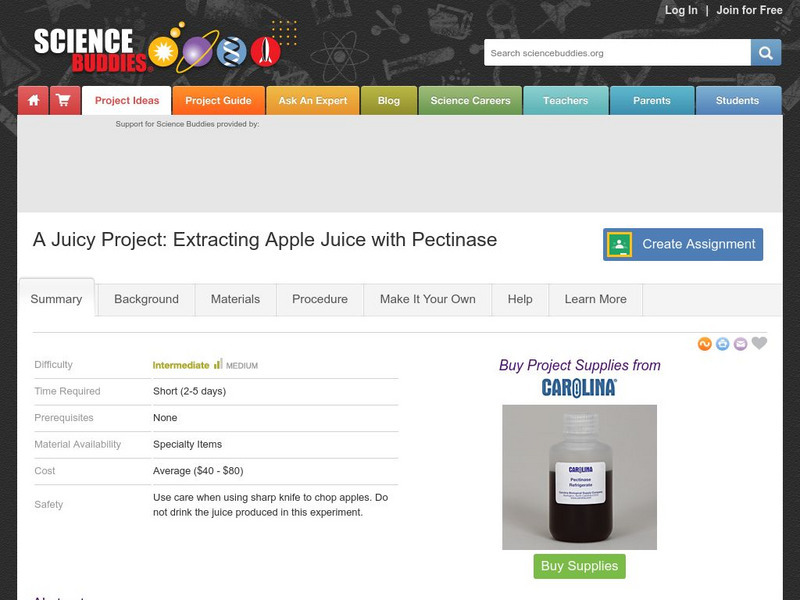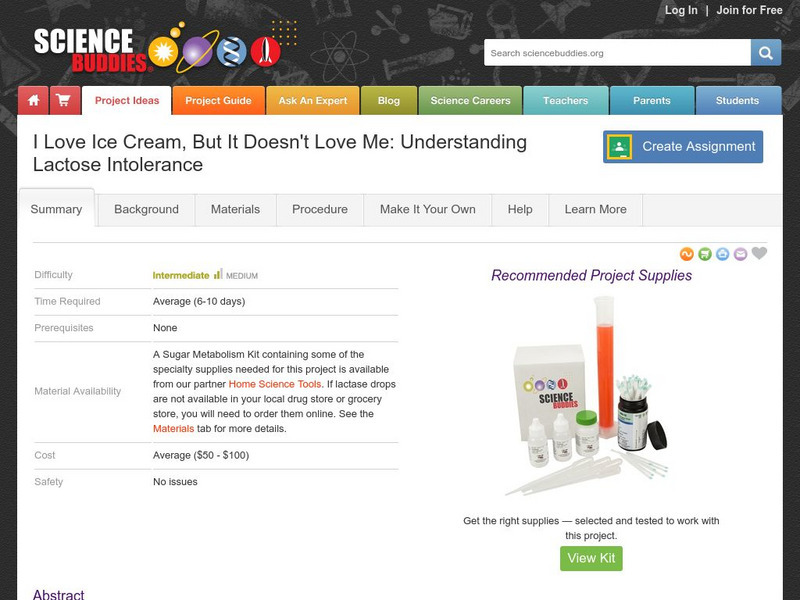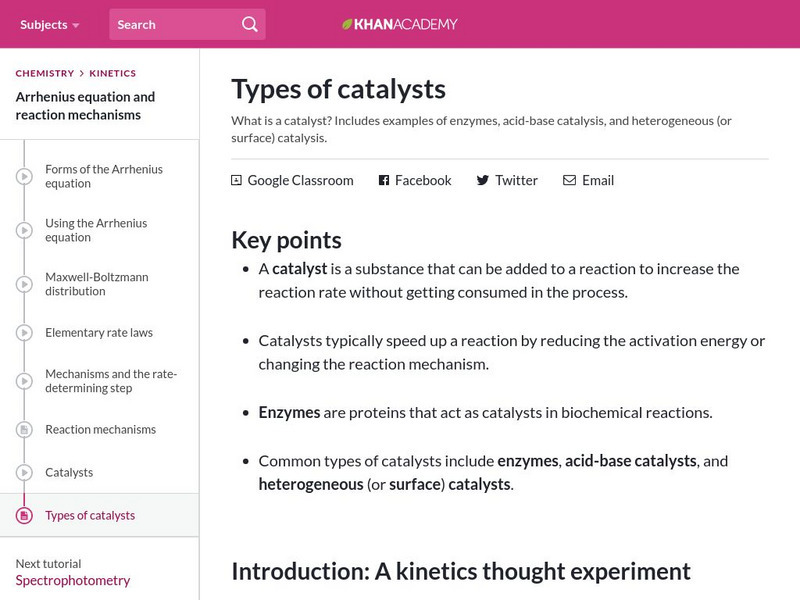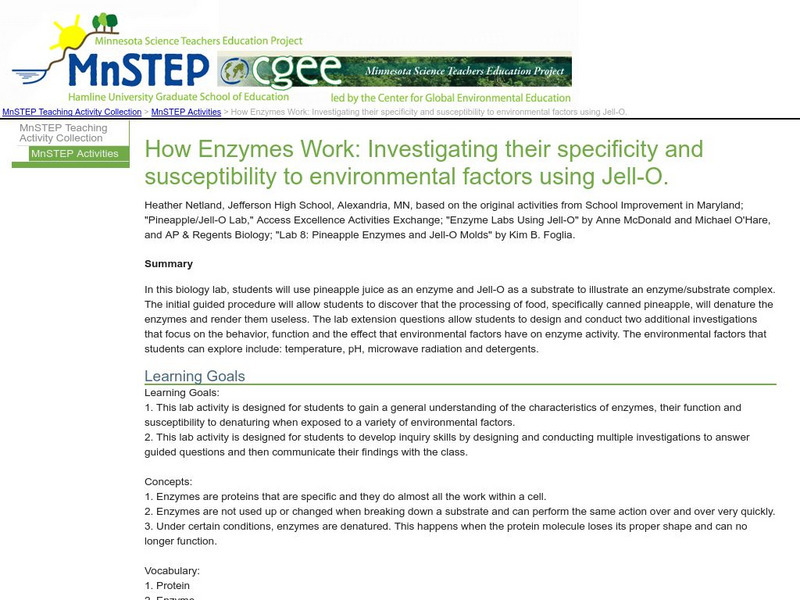Curated OER
Chemistry
In this chemistry worksheet, students describe an atom, its parts, the charges of these parts, and atoms life functions. Then they explain what the octet rule states for the placements of electrons around the nucleus of an atom. Students...
Curated OER
Your Digestive System
In this digestive system worksheet, 9th graders identify and explain any difference found in color of the mixtures in two glasses. Then they determine what enzyme was produced by glands in the mouth changing the starch in a chewed cracker.
Curated OER
Temperature and Enzymes
Students compare the times it takes the milk in each of two cups to curdle. They are told that an enzyme that is added to the milk, rennin, is involved in the natural curdling process of milk. Students are asked to consider what...
Curated OER
Catalase Enzyme
Pupils design and conduct an experiment to test their ideas about how to speed up or slow down the rate of an enzyme-catalyzed reaction. They have access to an array of physical and chemical factors that might influence enzyme activity....
Curated OER
Are Enzymes Specific for Their Substrates?
Students discover enzyme to substrate specificity. The experiment uses samples of glucose and lactose in combination with the enzyme lactase. Students observe the reaction between the lactose and the lactase; the lack of a reaction...
Curated OER
An Enzyme- Substrate Model
Students explore reaction rates of an enzyme-mediated reaction. They examine the effects of environmental variables on enzyme function. Students collect, graph, and analyze data relating to the reaction.
Curated OER
Applied Evolution: How Will We Get There from Here?
Students explore the basic process of natural selection and how people can manipulate that process today. The consequences of natural selection on daily life and the implications of evolutionary biology in basic and applied science is...
Curated OER
Small Intestine, Pancreas, Liver, and Gall Bladder
In this small intestine, pancreas, liver, and gall bladder worksheet, students fill in the blanks with information about these structures of digestion. Students research information about organ of the digestive system given.
Biology Pages
Kimball's Biology Pages: Enzymes
This is a good page for explaining the development and function of enzymes. It includes links to help with the chemistry and the biology that comes up.
Biology Pages
Kimball's Biology Pages: Phenylketonuria (Pku)
Read about phenylketonuria and the tests used to diagnose it in those who might have inherited this recessive trait.
Macmillan Education
W.h. Freeman Publishing: Allosteric Regulation of Enzyme
Reactions in cells must be regulated and one way to do this is using allosteric molecules. These regulators can activate enzymes or inhibit them. This tutorial explains exactly how allosteric regulation works using words, narration, and...
Science Buddies
Science Buddies: A Juicy Project: Extracting Apple Juice With Pectinase
This is a basic project on the effect of enzymes on apple slices. The goal of the project is to monitor enzyme activity by measuring the amount of apple juice released by pectinase.
Science Buddies
Science Buddies: Enzyme Catalyzed Reactions What Affects Their Rates?
Enzymes speed up chemical reactions by factors of at least a million. This project investigates some of the factors that affect how fast enzymatic reactions occur.
Science Buddies
Science Buddies: Liver Stinks!
Sometimes science can be really messy or use pretty disgusting ingredients. That is what it takes to understand how the world works, even if the experiment isn't pretty. If you like chemical reactions that stink and ooze foamy bubbles...
Science Buddies
Science Buddies: I Love Ice Cream, but It Doesn't Love Me: Lactose Intolerance
Pizza, milk shakes, and ice cream sundaes all contain dairy products, therefore they cannot be eaten by the majority of people around the world. Dairy products contain the sugar molecule lactose, and the majority of people on the planet...
The Association of the British Pharmaceutical Industry
Abpi: Digestion
A student-paced tutorial where learners read information, answer interactive review activities, and then take a self-checking quiz at the end of the lesson.
Howard Hughes Medical Institute
Hhmi: Biointeractive: Virtual Immunology Lab
This virtual laboratory demonstrates how an enzyme-linked immunosorbent assay (ELISA) is carried out and some of the key experimental problems that may be encountered. Students will learn about the assay procedure and the equipment and...
CK-12 Foundation
Ck 12: Proteins
[Free Registration/Login may be required to access all resource tools.] Students will learn about the structures and function of proteins and how we get protein in our diet.
Khan Academy
Khan Academy: Types of Catalysts
What is a catalyst? This Khan Academy resource includes examples of enzymes, acid-base catalysis, and heterogeneous (or surface) catalysis.
CK-12 Foundation
Ck 12: Amino Acids and Proteins
[Free Registration/Login may be required to access all resource tools.] In this module, students investigate amino acids, peptide bonds, and proteins. They also have the opportnity to discover the effect of an enzyme on a biochemical...
Science Education Resource Center at Carleton College
Serc: How Enzymes Work
In this biology lab, students use pineapple juice as an enzyme, and jello as a substrate to illustrate an enzyme/substrate complex.
The Association of the British Pharmaceutical Industry
Abpi: Enzymes
Animated learning exercise about all types of enzymes and their uses. Learn how different types of enzymes work and what effects them.
Other
Science Alive: Changing the Starch in "Yams" to Sugar
This lab activity provides students with the experience of using their own enzymes to convert starch to sugar (a disaccharide called maltose), then testing to see if the conversion has taken place.
Biology 4 kids
Biology4 Kids: Peroxisomes Another Enzyme Package
A short, informational article which explains the structure and function of peroxisomes inside a cell.
























